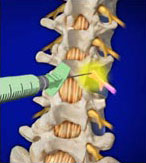Did you know?
If you can answer yes to any of the following questions, you should consult a spine specialist:- Has your low back pain extended down your leg?
- Does your leg pain increase if you lift your knee to your chest or bend over?
- Have you had severe back pain following a recent fall?
- Have you had significant back pain lasting for more than 3 weeks?
- Have you had back pain that becomes worse when you rest, or wakes you up at night?
- Do you have persistent bladder or bowel problems?
Symptoms of a Radiculopathy
The most common symptom of lumbar radiculopathy is sciatica. The most common symptom of cervical radiculopathy is pain that radiates down into your arms from your neck. This disease is often caused by direct pressure from a herniated disc or degenerative changes in the lumbar spine that cause irritation and inflammation of the nerve roots. Radiculopathy usually creates a pattern of pain and numbness that is felt in your arms or your legs in the area of skin supplied by the sensory fibers of the nerve root, and weakness in the muscles that are also supplied by the same nerve root. The number of roots that are involved can vary, from one to several, and it can also affect both sides of the body at the same time.
Treatment Options for Radiculopathy
 Cervical radiculopathy might be treated with a combination of corticosteroids (powerful anti-inflammatory drugs) or non-steroidal pain medicine (Motrin or Aleve). Steroids might be prescribed either orally or injected epidurally (into the dura, which is the membrane that surrounds the spinal cord).
Cervical radiculopathy might be treated with a combination of corticosteroids (powerful anti-inflammatory drugs) or non-steroidal pain medicine (Motrin or Aleve). Steroids might be prescribed either orally or injected epidurally (into the dura, which is the membrane that surrounds the spinal cord).
Physical therapy might include gentle cervical traction and mobilization, exercise, and other treatments to reduce pain. If significant compression on the nerve exists to the extent that motor weakness results, surgery might be necessary to relieve the pressure.
- Medications
- Acupuncture
- Physical Therapy
Conservative Treatments:
- Spinal Fusion
- Laminectomy
- DYNESYS® Spinal System
Surgical Treatments:
Latest news
Visit our media library for access to all of our news videos.
The Spine Institute is often in the news pioneering new treatments to help the reported 34 million Americans 18 years and older who suffer lower back pain, and another 9 million who suffer neck pain. Watch the news coverage here.
-->
